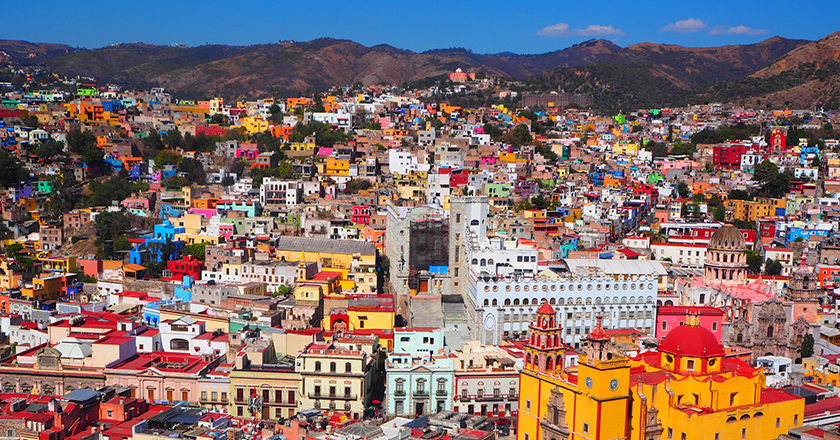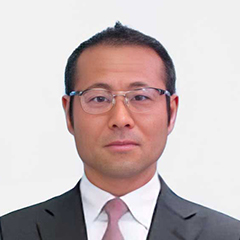Mexican people’s smiles are masks?
Many Japanese people picture Mexico as a place with jolly people who like festivals (fiestas).
However, in his major work The Labyrinth of Solitude (El laberinto de la soledad, 1960), the writer Octavio Paz (1914-1998), who was born in Mexico City and was awarded the Nobel prize in literature, said that Mexican people still have fear and distrust as a legacy from the country’s time as a Spanish colony.
“In other words, Mexicans seem to close themselves up to protect themselves. Their faces are masks, and smiles are masks. They are pushed into their difficult solitude, and for him who is acrid but careful, everything such as silence and words, manner and contempt, irony and submission, is helpful for their protection.” (translated by TAKAYAMA Tomohiro and KUMAGAI Akiko, Hosei University Press, 1982)
“Mexican masks” are worldly wisdom that people who were forced to superficially obey acquired to survive, and they are a so-called defender instinct.
The area used to flourish with highly-advanced civilizations such as the Maya and the Aztecs. However, after the “discovery” of the new continent by Columbus, it continued to be ruled by the conquerors (conquistadores) for 300 years. Through the clashes and conflicts between the ancient culture and Western culture, mixing between natives and white people also advanced.
As Paz stressed through the paradox of “solitary Mexicans liking festivals and public gathering,” “jolliness” is merely one aspect of the people. At the other end of the spectrum of superficial cheerfulness, there is a dim shadow, and there is an indescribable gradation between them.
For example, I think we have recently had more opportunities to encounter the term “Global South.” If we look back the modern and contemporary history of Mexico with this as a keyword, we start to see how diverse and complicated the issues this country has had to bear are.
In the first place, the definition of “Global South” is unclear, and there is a range of interpretations depending on who you listen to. Primarily it indicates the group of countries that were referred to as the Third World during the cold war era, belonging to former colonies in such regions as Asia, Africa, and Latin America, and is defined as the traditional “south” that is used for example in the case of the so-called North-South issue. The Third World was a group other than the First World indicating the Western countries and the Second World indicating the Eastern countries.
On the other hand, some arguments define it by social category, which distinguishes the north as people who are benefiting from the globalized market economy and the south as people who are excluded from that, without limiting it to the residing countries and areas.
In any of these definitions, Mexico, up until a certain time, was a typical example of the south for sure. However, in relation to the United States, its neighboring superpower, Mexico would largely waver economically and politically.
Origin of Mexico as part of the Global South
In a little more than 20 years after becoming independent from Spain in 1821, Mexico lost more than half of its land in the Mexican-American War. Since then, American tycoons have advanced in full swing, and from the 20th century onward it became a base to supply resources and food to the neighboring northern country.
Most importantly, at the same time, it continued to bear the legacy from the time of Spanish rule. Especially in the regional and local areas, latifundia and oligarchy rule were maintained.
In other words, it is a structure in which there are many small-scale family-run farms and small-scale land owning farms in poor areas dependent on primary industry focusing on agriculture, while a small number of white people own vast farm land, and such group also makes up the political leaders in each area.
This is a feature that can also be seen in other Latin American countries which used to be Spanish colonies. In that sense, we can say that Mexico also has an identity as part of the Global South.
However, in the latter half of the 20th century, Mexico was forced to radically approach “the North.”
Originally from the 1940s to 60s, to take advantage of the temporary lowering presence of the U.S. due to the war, Mexico increased its nationalism and adopted a protectionist policy to cultivate domestic industry (although strictly speaking, including foreign capital companies).
However, since the latter half of 1970s, it started to promote domestic industry development by receiving loans from international financial institutions and private banks from “the North.” Then in the early 1980s, also influenced by the increase in repayment interest rates due to the U.S. high interest rate policy, it finally fell into default.
The rise of this cumulative debt crisis triggered Mexico to accept a conditional loan to defer the repayment partially. The conditionality was the major turn to policies such as tariff elimination and trade liberation. Through this, the Mexican government ended its external protectionist policy and started to introduce neoliberal policy.
The epitome of that was the North American Free Trade Agreement (NAFTA), which liberalized the trade and movement of capital between the U.S. We can say that this was an approach to an advanced nation through economic integration, i.e., symbolic approach to the Global North.
However, on January 1, 1994, when NAFTA took effect, in Chiapas, the most impoverished state in the south of Mexico, the Zapatista Army of National Liberation (EZLN) consisting mainly of Maya natives, rose up against NAFTA.
Although resorting to violence should be reprimanded, EZLN claimed “NAFTA will further accelerate the poverty and economic gap in this country” and this reacknowledged Mexico’s economic bipolarization and social divide, where 60% of citizens belong to the poverty class.
In fact, through trade liberalization, large amounts of cheap American-produced grain flew into Mexico, and especially the operation of small-scale family-run farms in the southern area gradually became unsustainable. As a result, many people abandoned farming, and jobs were lost mainly among farmers, leading to current issues of cross-border immigrants and a drug economy.
In other words, through the effectuation of NAFTA, while Mexico became economically connected to the world of the Global North – North America, centering around the U.S. – the social situation, including the resistance movement by the native population, ironically revealed the legacy from the colonial era, which is its historical roots and its position in the Global South – making visible the absolute poverty that is an attribute of the south.
The pink tide and the reality of modern Mexico
Mexico has now entered a new phase. In the most recent Mexican presidential election, current President López Obrador (who assumed office in December 2018) won a landslide victory, and international media reported this as “the first left-wing government is born.”
President Obrador professed the turn away from the neoliberal policy which has been adopted for the past 40 years, and in order to correct the traditional distortion of resource allocation, he advanced the policy to raise the minimum wage, enhance the pension system and scholarship system, and improve the social welfare system and medical insurance system.
These are policies to provide a safety net to socially vulnerable people. The factor that enabled this policy change was the effort to mobilize the masses by making the poverty group, which accounts for more than half the population, their support base.
This trend arose not only in Mexico but also in the entire Latin America region from early 2000s, and in a quarter of a century, it has strengthened and weakened, losing impetus and regaining momentum. This is the current known as the pink tide.
Although its characteristics differ by country, various arguments were developed by various advocates in the framework of the leftward tilt (= pink), but it did not tilt as far as communism (= red).
In any case, concerning Mexico, social structural reform has not developed to the extent of being appraised by the pro-pink tide people, and it is burdened with serious problems such as environmental conservation, protection of natives’ rights, gender, and social violence.
On the other hand, criticism by anti-pink tide people claiming that it is populism, or a view that by pork-barreling it is trying to sweeten people with complaints, are not entirely irrelevant, but way too one-sided and are underestimating this country’s history and tradition of resistance and revolutionary movement under the colonialism and social movement after independence. In fact, many self-sustained grassroots social movements are still rising now and making various demands to the current government.
I actually think that the Obrador administration is a government which embodies a contemporary Mexico which wavers between “the north” and “the south” rather than the one that should be superficially interpreted in the framework of the classic left-wing (or pink tide). This stance is clearly expressed in the series of movements surrounding the revision of the trade agreement.
In 2018, Mexico and the U.S. revised NAFTA and newly concluded the United States-Mexico-Canada Agreement (USMCA) (which took effect in July 2020). This revision was made against the situation when the then U.S. Trump administration pressured Mexico to review the agreement saying that it cannot overlook the increase of trade deficit against Mexico.
However, against the prediction that the two countries would definitely clash, the revision negotiation proceeded smoothly. Moreover, although the U.S. trade deficit against Mexico has increased or decreased depending on the year since 2018, (as opposed to the initial intention of the U.S. Trump administration) it is demonstrating more of an increasing trend. What does this mean?
While both countries were antagonistic to each other and the political conflict continued during the 2016 U.S. presidential election and the 2018 Mexican presidential election, American and Canadian companies have already gained the most efficient access concerning resource development, finance, communication service, and production and transportation of goods in Mexico, making use of the USMCA.
That is to say, while politically advocating criticism against the neoliberal policy and reallocation of wealth, and planting one foot in camp of the domestic poverty class and regions (= “south”), it economically focused on the wealthy class and global companies (= “north”) through the USMCA.
Amid the widening political bipolarization and social divide over right and wrong of the neoliberal policy, Mexico is now wavering between the Global South and the Global North at the same time. This reality of contemporary Mexico cannot be seen without escaping from the preconception that Japanese tend to have.
Furthermore, from the American point of view, the USMCA is thought to be an important international system to build a comprehensive Northern American alliance between Canada and Mexico, rather than globalism. In fact, it is also possible to interpret it as regionalism to strengthen the tie within the Northern American region, and through the “enclosure” of these two countries by the U.S., the aim to push out China from the North America region shows through.
In the complicated contemporary world, it is impossible to solve the economic, political, and societal problems from one country. That is why I think it is important to try to understand the other country’s history and public awareness comprehensively with the recognition that they are complicated and multi-layered, instead of simplifying them and feeling like we understand.
* The information contained herein is current as of July 2023.
* The contents of articles on Meiji.net are based on the personal ideas and opinions of the author and do not indicate the official opinion of Meiji University.
* I work to achieve SDGs related to the educational and research themes that I am currently engaged in.
Information noted in the articles and videos, such as positions and affiliations, are current at the time of production.


